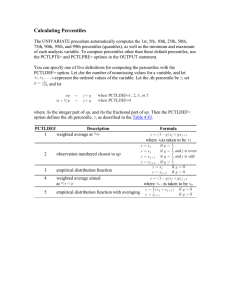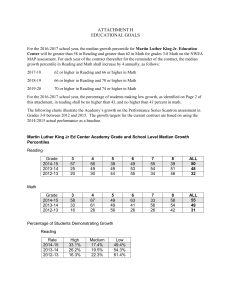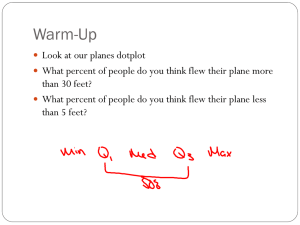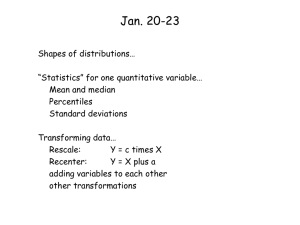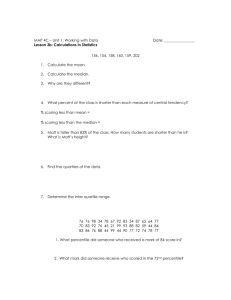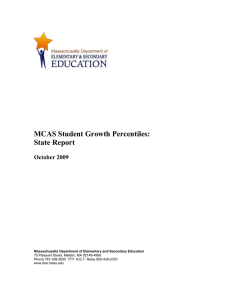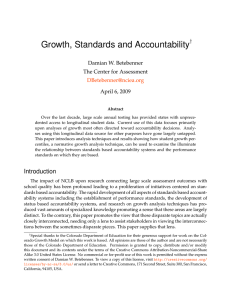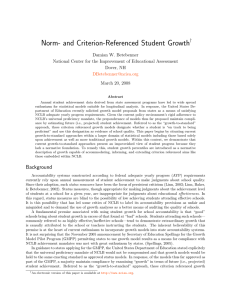BA 210, Section 3.1 - Valdosta State University
advertisement
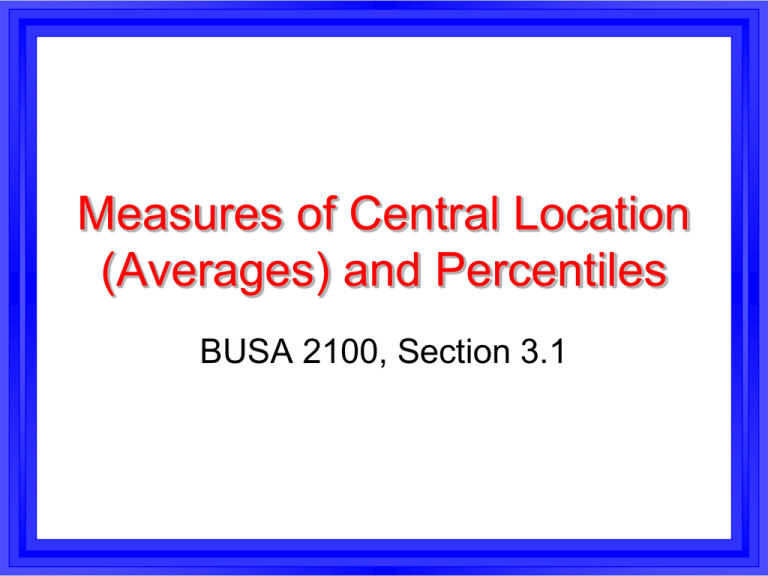
Measures of Central Location
(Averages) and Percentiles
BUSA 2100, Section 3.1
Introduction
Values of a variable tend to cluster
around a central point.
A measure of central location indicates
a center, average, or typical value.
A measure of central location (average)
helps summarize data concisely with
one value.
1st Type of Average: Mode
Definition: The mode is the item that
occurs most often.
Example 1 – Consider this data set:
{96,91,91,87,84, 82,79,75,72,69,62}.
The mode is 91 since it occurs twice.
But 91 isn’t a “central” or “typical” value.
Another problem: some data sets have
no mode, e.g. set above with one 91
removed.
Mode (Page 2)
Some data sets have more than one
mode. Example: Height of adults is
bimodal (two modes). Why?
So the mode is not very useful and not
reliable except for categorical data.
Example 2: (categorical data) Ask
students to state their favorite kind of
pie.
2nd Type of Average: Median
Definition: The median is the middle
item of a ranked set of data.
It is the (n+1)/2 th item in a ranked set
of n items.
Example 1: Find the median of this set
of 7 items. {75,64,82,96,72,47,59}
Median (Page 2)
Example 2: Add 89 to the previous set.
{89,75,64,82,96,72,47,59}
3rd Type of Average: Mean
Definition:
The sample mean, X-bar =
Sum of the X’s divided by n, where
n = number of items in the data set
(sample).
Example 1: {89,75,64,82,96,72,47,59}
Mean (Page 2)
Mean is the most widely used and best
measure of central location except in
one situation (to be discussed later).
Advantages of the mean: (1) More
comprehensive because it uses all of
the data (not just the center item(s)).
(2) Combined or weighted means can
be calculated.
Mean (Page 3)
Example 2 (combined mean): Class #1
had a mean test score of 80; Class #2
had a mean test score of 60.
What is the overall mean for both
classes combined?
Is it 70, the average of 80 and 60?
Mean (Page 4)
Class #1 has 40 students; Class #2 has
10 students.
Mean (Page 5)
Example 3 (weighted mean): In a
course, a professor gives 3 tests and a
final exam, and requires a project.
The final exam counts 1 1/2 times as
much as each test and the project
counts twice as much as each test.
Charles Malone made 80, 74, 67, 86,
and 90. What is his course average?
Mean (Page 6)
Note: The unweighted mean is 79.4.
Mean (Page 7)
The median is preferred to the mean if
there are extreme values present.
Example 4: Incomes for 5 families are:
{$30K, $40K, $50K, $60K, $820K}
Mean = $1,000,000 / 5 = $200,000, but
this is not a “center” or “typical” value.
Median = $50,000 (more accurate)
Percentiles
Definition: The pth percentile is a value
that is > p percent of the values in a
data distribution.
Values for p: 0, 1, 2,...,98, 99, 99.5, 99.9
Example: If you were in the 86th
percentile on a test, what does that
mean?
Percentiles (Page 2)
Three steps for calculating percentiles:
(1) Arrange data in ascending order
(2) Calculate index (rank): i = (p/100)* n.
(a) If i is not a whole number, round
up to the next whole number.
(b) If i is a whole number, use i + .5 .
(3) Identify the answer.
Percentiles (Page 3)
Example: {2450, 2500, 2650, 2430, 2355,
2260, 2490, 2680, 2540, 2775, 2525, 2465,
2610, 2390} are monthly salaries for 14
business graduates.
Find the 67th percentile.
Step 1: Arrange in ascending order: {2260,
2355, 2390, 2430, 2450, 2465, 2490, 2500,
2525, 2540, 2610, 2650, 2680, 2775}
Percentiles (Page 4)
Find the 50th percentile.
Percentiles (Page 5)
The 50th percentile is the median.
The 25th percentile is the 1st quartile.
The 75th percentile is the 3rd quartile.
